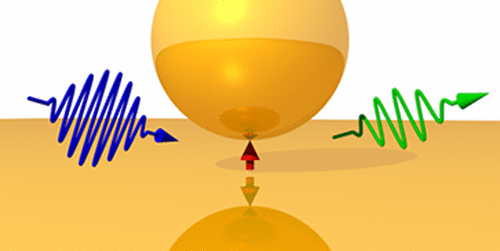当前位置:
X-MOL 学术
›
ACS Photonics
›
论文详情
Our official English website, www.x-mol.net, welcomes your feedback! (Note: you will need to create a separate account there.)
Suppressed Quenching and Strong-Coupling of Purcell-Enhanced Single-Molecule Emission in Plasmonic Nanocavities
ACS Photonics ( IF 7 ) Pub Date : 2017-11-01 00:00:00 , DOI: 10.1021/acsphotonics.7b00668 Nuttawut Kongsuwan 1 , Angela Demetriadou 1 , Rohit Chikkaraddy 2 , Felix Benz 2 , Vladimir A. Turek 2 , Ulrich F. Keyser 2 , Jeremy J. Baumberg 2 , Ortwin Hess 1
ACS Photonics ( IF 7 ) Pub Date : 2017-11-01 00:00:00 , DOI: 10.1021/acsphotonics.7b00668 Nuttawut Kongsuwan 1 , Angela Demetriadou 1 , Rohit Chikkaraddy 2 , Felix Benz 2 , Vladimir A. Turek 2 , Ulrich F. Keyser 2 , Jeremy J. Baumberg 2 , Ortwin Hess 1
Affiliation

|
An emitter in the vicinity of a metal nanostructure is quenched by its decay through nonradiative channels, leading to the belief in a zone of inactivity for emitters placed within <10 nm of a plasmonic nanostructure. Here we demonstrate and explain why in tightly coupled plasmonic resonators forming nanocavities “quenching is quenched” due to plasmon mixing. Unlike isolated nanoparticles, such plasmonic nanocavities show mode hybridization, which can massively enhance emitter excitation and decay via radiative channels, here experimentally confirmed by laterally dependent emitter placement through DNA-origami. We explain why this enhancement of excitation and radiative decay can be strong enough to facilitate single-molecule strong coupling, as evident in dynamic Rabi-oscillations.
中文翻译:

等离子体纳米腔中赛尔增强单分子发射的抑制猝灭和强耦合。
金属纳米结构附近的发射极通过其通过非辐射通道的衰减而被淬灭,从而导致人们相信放置在等离激元纳米结构内小于10 nm的发射极处于无活性区域。在这里,我们证明并解释了为什么在紧密耦合的等离子共振器中,由于等离激元混合而形成纳米腔时,“淬灭被淬灭”。与孤立的纳米粒子不同,此类等离激元纳米腔显示出模式杂交,可通过辐射通道极大地增强发射极的激发和衰减,此处通过DNA折纸的横向依赖性发射极位置进行了实验证实。我们解释了为什么激发和辐射衰减的这种增强足够强以促进单分子强耦合,如在动态拉比振荡中所证明的那样。
更新日期:2017-11-02
中文翻译:

等离子体纳米腔中赛尔增强单分子发射的抑制猝灭和强耦合。
金属纳米结构附近的发射极通过其通过非辐射通道的衰减而被淬灭,从而导致人们相信放置在等离激元纳米结构内小于10 nm的发射极处于无活性区域。在这里,我们证明并解释了为什么在紧密耦合的等离子共振器中,由于等离激元混合而形成纳米腔时,“淬灭被淬灭”。与孤立的纳米粒子不同,此类等离激元纳米腔显示出模式杂交,可通过辐射通道极大地增强发射极的激发和衰减,此处通过DNA折纸的横向依赖性发射极位置进行了实验证实。我们解释了为什么激发和辐射衰减的这种增强足够强以促进单分子强耦合,如在动态拉比振荡中所证明的那样。


























 京公网安备 11010802027423号
京公网安备 11010802027423号